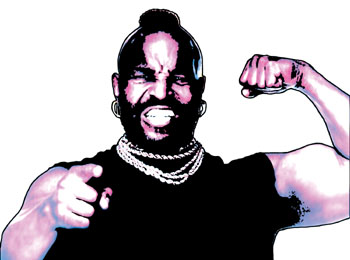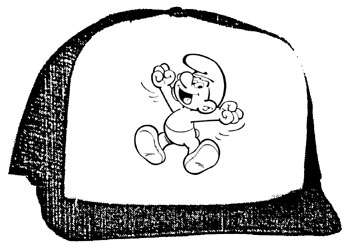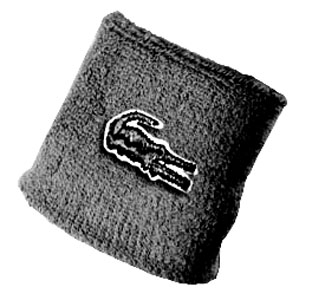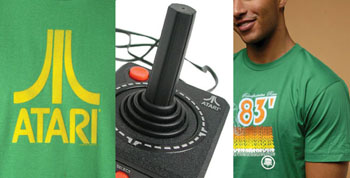![[Metroactive Features]](http://metroactive.com/features/gifs/feat468.gif)
[ Features Index | Silicon Valley | Metroactive Home | Archives ]
If it sometimes seems as if marketers are climbing inside your childhood for their advertising imagery--they are
By Traci Vogel
WHAT, in the name of all that is good about America, were Mary Lou Retton, Mr. T, George Hamilton and Loni Anderson doing on my television in a commercial for something called Sizzle & Stir?
This is where it all began: the questions, the searching, the gnawing doubts. It was bad enough when John Travolta's career lurched back into zombie reanimation, but watching Mr. T hawk a packaged dinner mix just brought the terrible truth of it all home:
My childhood was becoming marketing fodder.
Sure, for Baby Boomers the experience is nothing novel. The Beatles, hippie culture and even a resurrected Martin Luther King Jr. have cameo'd in advertisements for everything from antihistamines to life insurance. It's all part of what public relations firms call nostalgia marketing. The premise is simple: link a product to a person, era or song that evokes a simpler, happier time, and the good feelings those things prompt will attach to the product itself.
Not old enough to have a memory associated with hippie culture? No problem. The commercial, with a soundtrack, a few strokes of atmosphere and a minuscule story line, creates what Douglas Coupland termed "legislated nostalgia"--defined by online dictionary Word Spy as "nostalgic images or ideas presented in such a way that even people who weren't yet born seem to 'remember' that time."
Nostalgia marketing and legislated nostalgia are such potent marketing techniques that they're being used by everyone from politicians to McDonald's with increasing frequency. The tactic is especially effective during difficult economic or socially stressful times. After all, as Business Week noted in a cover story about "The Nostalgia Boom," "Social experts say much of the appeal of nostalgia stems from a longing for a return to simpler times."
Well, as third-graders everywhere would say, "Duh." Nostalgia marketing isn't exactly subtle. It tugs at the basest emotional nerve center: happy memories of childhood. It's no surprise that images of '50s and '60s culture worked on the Baby Boomers: they're a sentimental generation, anyway. Generations X and Y, on the other hand, are supposedly so disinterested, disaffected and hard to pin down that the only label suitable for us is a nonlabel. We're used to advertising's games. We're pop-culturally world-weary. Nostalgia couldn't possibly work on us, right?
Wrong, says Peter Johnson, strategic account manager at 3 Marketeers Advertising in San Jose. And you don't have to look very far for proof: "I would only go to the very popular television programming on some of the music channels; one, for example, being I Love the '80s," Johnson says. "I haven't seen the Nielsens, but I know that show is incredibly popular with people our age [Gen-Xers]."
Retro--any kind of retro--is in, Johnson affirms. From the '60s Catch Me If You Can mod look to '80s New Wave mod, the stuff is "all over TV."
It's easy to understand why the '60s are looked back on fondly, but why the '80s? Why romanticize a decade in which big hair and shoulder pads were two of the best things happening?
"I think it has to do with the age of who's buying products and who we are," says Johnson. "The people that are grown-up--we all know that everything's been done, every song's been written. We grew up [in the '80s]. It makes sense to us; it's something we can latch onto. We're the people buying the product; we're the parents."
And we want Mr. T, damn it.
Who's Zooming Who?
Nostalgia, as coined by Swiss doctor Johannes Hofer in 1688, was originally a medical diagnosis referring to "the pain a sick person feels because he is not in his native land, or fears never to see it again." Throughout the next several hundred incoherent years, the meaning morphed to cover that general melancholy one feels about the things one had and lost. In the slapstick definition, nostalgia is "the ability to recall the past fondly, despite the facts."
If you grew up, like I did, in the late '70s and '80s, most of your memories probably center hazily around that last part: "despite the facts." Childhood will always be recalled as simple, but the truth is that for Gen-Xers, childhood wasn't about the Cold War or union strikes or Reaganomics. It was all about the products. Ours was the first generation in which kid stuff was completely commodified--and in pretty sophisticated ways.
In 1983, the FCC (with the encouragement of the Reagan administration) did away with regulations requiring children's TV programming to be free from advertising content. This ushered in the new era of the "30-minute children's product feature," which is a sanitized way of saying, "a kids' show made for the sole purpose of selling products." Hence a new batch of He-Man toys and villains showed up in the stores each week to match the episode that had aired. Then there were the Transformers tie-ins for boys, the My Little Pony tie-ins for girls. There were lunchboxes with every conceivable TV show emblazoned on their sides. We were walking advertisements before it became a cliché.
When you got older, there were parallel commercial tie-ins, such as the popular Heineken advertisement T-shirt that humorously urged you to "Grab a Heiney." Today, you can buy that original "Grab a Heiney" T-shirt on vintagevantage.com for $1,050. If that doesn't prove Gen-X is sentimental, I'll buy you a beer.
Advertisers have been quick to clue in to Gen-X's rampant and very product-oriented nostalgia. The nostalgia-marketing machine is on full throttle. Old Navy television commercials mimic The Love Boat and The Brady Bunch; '70s TV show after '70s TV show is revived for a movie remake. A song by the Tom Tom Club resurfaces for a Kia commercial soundtrack. And Gen-Xers--and Gen-Yers, infected with legislated nostalgia--are lapping up the product. Who doesn't want an easy trip down Sesame Street Lane? Buying stuff is the fastest way to get there.
All of which makes it kind of depressing to think of how much of the '70s pop culture centered around asserting your own individual identity. Remember "Zoom"? Remember "Free to Be You and Me"? Just as the ideologies of '60s culture evaporated in the co-option of the '60s style, so has any actual ideological substance of the '70s. The message doesn't matter--it's the media that advertisers are interested in.
Peter Johnson thinks the current-day message, if there is one, is amusement: "If anything, I think if we're using [the '70s and '80s references] from a nostalgic point; we're laughing at [them]. But that may be just as effective. Humor is one of the best advertising tools available. People, especially Gen-Xers, are just smarter towards advertising. We have a sense of what you're trying to sell and how you're trying to sell it."
As many marketing experts note, nostalgia is turning on a faster and faster track, producing more and more media, much sooner than anyone imagined. What used to take 20 years to reach cool levels of kitsch might now be sentimentalized in five. Companies often try to create their own cycle of nostalgia, bringing back old logos or spokespeople/spokescharacters. Wendy's revived "Dave" just five months after he died, with a tag line about doing it "Dave's Way." Kentucky Fried Chicken revived the Colonel, too, but as a hip-hop cartoon character.
Commercials aren't the only things being kitschified. Walk into an Urban Outfitters, and it is possible to buy exact replicas of stuff you might have worn 15 to 30 years ago--terry-cloth wristbands, Nirvana T-shirts, rainbow barrettes. Sales of reproduction lunchboxes are brisk. Clubs make most of their weeknight money on '80s DJ nights. My boyfriend ordered an entire Detroit Tigers uniform, reproduction circa 1975 (don't worry, the only part he wears in public is the socks).
What do all these emotional machinations mean, aside from a little extra pocket cash for Mr. T? Is anyone worried that the commercial exploitation of nostalgia translates into corrupted childhoods for every generation from now on? Are our memories being copyrighted? Is this the end of history? Should we care?
Heaven Is A Truck
They emerge from the verdant Hollywood afternoon, coalescing into white-clothed figures jumping rope on the crew-cut lawns of suburbia. The camera soars by with the arc of an admiring gaze, and the music, the echo of proms past, swells: "Can you imagine when this race is won? Turn our golden faces into the sun ..." Alphaville, "Forever Young," 1984. A sign looms: "Now Leaving Childhood." The jellybean shape of a Saturn sedan comes into view, driving off on an endless highway.
This recent Saturn commercial takes nostalgia marketing to a new level. It is self-consciously melancholic, tapping into Gen-X's well-researched desire to never have to grow up. If growing up could be accomplished with the purchase of a car, many of us would dump our therapists and head for the auto lot.
This yawning gulf between childhood and adulthood is the territory where nostalgia dwells, and it is here that nostalgia reconnects to its original definition of homesickness. Exile--from a place, a person or a thing--is nostalgia's precondition. Remember "You can't go home again"? That was not a physical prescription.
In her book The Future of Nostalgia, Harvard professor Svetlana Boym draws on the medical origins of the word to expound on its sociological import. She quotes Johannes Hofer's original notes. Nostalgia, she writes, was said to produce "erroneous representations" that caused the afflicted to "lose touch with the present."
Those afflicted acquired an "'indifference towards everything,' confusing past and present, real and imaginary events." Nostalgia "operated by an 'associationist magic,' by means of which all aspects of life related to one single obsession. In this respect, nostalgia was akin to paranoia, only instead of a persecution mania, the nostalgic was possessed by a mania of longing. On the other hand, the nostalgic had an amazing capacity for remembering sensations, tastes, sounds, smells, the minutiae and trivia of the lost paradise."
Excuse the trivialization, but this description sounds so much like many of my twenty- and thirtysomething friends that I am thinking of recommending the reintroduction of "nostalgic" as a psychiatric diagnosis in the next Diagnostic and Statistic Manual of Mental Disorders. Like the homesick, Gen-Xers are often afflicted with an indifference toward current events and a corresponding, curiously strong engrossment in the past. I know people who can name every character on Gilligan's Island and yet have no idea who Paul Wolfowitz is. Like first-generation immigrants decorating their sideboards with homeland tchotchkes, Gen-Xers cover their computers with Star Wars figurines.
And this all makes sense. It's comforting. It's about as spiritual as we get. As Boym continues, "Modern nostalgia is a mourning for the impossibility of mythical return, for the loss of an enchanted world with clear borders and values; it could be a secular expression of a spiritual longing, a nostalgia for an absolute, a home that is both physical and spiritual, the Edenic unity of time and space before entry into history."
But, she adds, the nostalgic will never find his "spiritual addressee." Instead, "Encountering silence, he looks for memorable signs, desperately misreading them."
By Traci Vogel
IF THERE is a spiritual center to the new commodification of nostalgia, it is the clothing, furniture and knickknack chain store Urban Outfitters. Packed with colorful merchandise, the stores draw high school and college students alongside nostalgic Gen-Xers.
On one recent visit, a high school-age couple played the arcade game Ms. Pac Man, which stood next to an old Centipede arcade game. On a display table behind them, a pair of '80s-era Air Jordan reproduction tennis shoes sported the surprisingly reasonable price tag of $80. A T-shirt emblazoned with the Atari logo was neatly folded beside them. It was worth wondering: Would the young couple playing Ms. Pac Man be able to contextualize these two cultural artifacts?
At Urban Outfitters, you can purchase a reproduction of the original Atari game system--a box, joystick and big-pixel games like Pong and Asteroids--for $32. Or you can plunk down for a Eames-style dining table and chairs just like the ones seen on That '70s Show--which is a nice example of legislated nostalgia--for just $1,500.
Urban Outfitters excels in making nostalgia for pseudobohemian cool. The franchise's founder, Richard Hayne (also CEO of the Anthropologie stores), opened the first store in Philadelphia in 1975. Last year, in the midst of a retail free fall that crushed even giants like K-Mart, the store posted an 83 percent increase in profits and opened 13 new outlets.
But as Jonathan Valania of the Philadelphia Weekly reported recently, "While the typical Urban Outfitters shopper is likely to be liberal-minded ... the fiftysomething Hayne is mom-and-apple-pie conservative. He and his wife, Margaret, have contributed $13,150 to the campaign coffers of Paleolithic right-wing Republican Sen. Rick Santorum and his Political Action Committee over the years."
Not only that, but most of Urban Outfitters' nostalgic fare is produced in sweatshops located in Turkey, India or Sri Lanka.
[ Silicon Valley | Metroactive Home | Archives ]
Copyright © Metro Publishing Inc. Metroactive is affiliated with the Boulevards Network.
For more information about the San Jose/Silicon Valley area, visit sanjose.com.
![]()

Retooling Mr. T

Hats Off: Sorry, you can't buy this cap, but you can cut and paste it on Photoshop and put it on Mr. T's head.

Preppy Sweat: The '80s were all about Izod.

Mane Attraction: Selling to Gen X and Y is a cinch.

Sweat-Shopping to the Oldies
Send a letter to the editor about this story to letters@metronews.com.
From the July 17-23, 2003 issue of Metro, Silicon Valley's Weekly Newspaper.